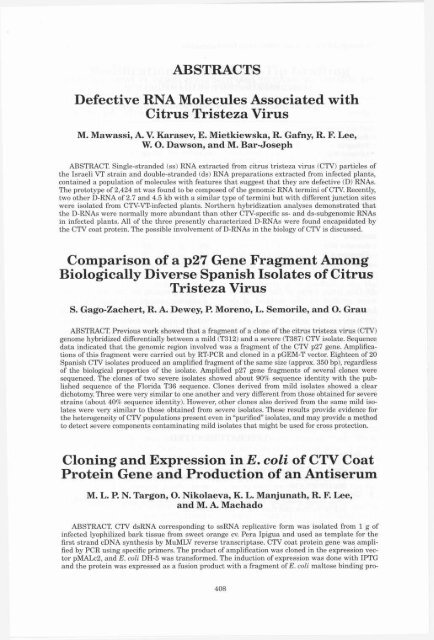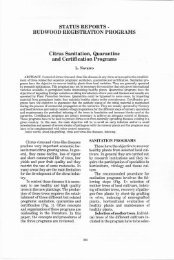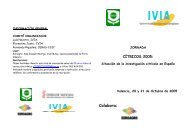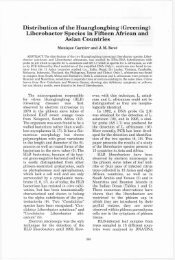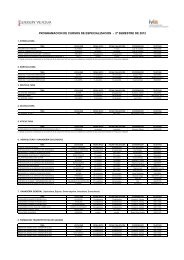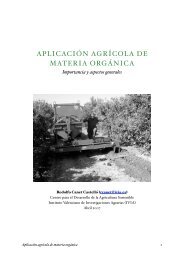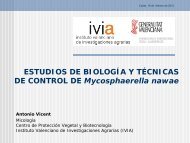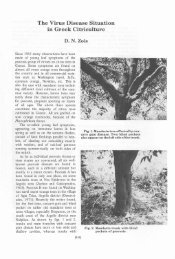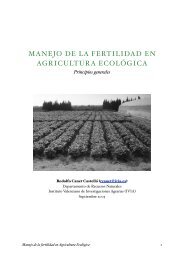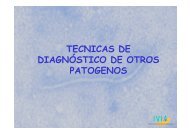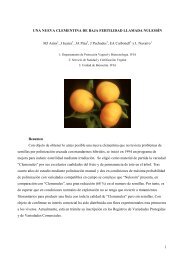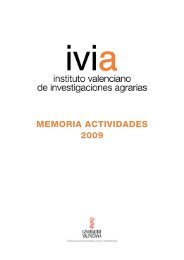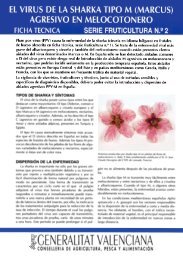ABSTRACTS Defective RNA Molecules Associated with Citrus ... - IVIA
ABSTRACTS Defective RNA Molecules Associated with Citrus ... - IVIA
ABSTRACTS Defective RNA Molecules Associated with Citrus ... - IVIA
You also want an ePaper? Increase the reach of your titles
YUMPU automatically turns print PDFs into web optimized ePapers that Google loves.
<strong>ABSTRACTS</strong><br />
<strong>Defective</strong> <strong>RNA</strong> <strong>Molecules</strong> <strong>Associated</strong> <strong>with</strong><br />
<strong>Citrus</strong> Tristeza Virus<br />
M. Mawassi, A. V. Karasev, E. Mietkiewska, R. Gafny, R. F. Lee,<br />
W. 0. Dawson, and M. Bar-Joseph<br />
ABSTRACT. Single-stranded (ss) <strong>RNA</strong> extracted from citrus tristeza virus (CTV) particles of<br />
the Israeli VT strain and double-stranded (ds) <strong>RNA</strong> preparations extracted from infected plants,<br />
contained a population of molecules <strong>with</strong> features that suggest that they are defective (D) <strong>RNA</strong>s.<br />
The prototype of 2,424 nt was found to be composed of the genomic <strong>RNA</strong> termini of CTV. Recently,<br />
two other D-<strong>RNA</strong> of 2.7 and 4.5 kb <strong>with</strong> a similar type of termini but <strong>with</strong> different junction sites<br />
were isolated from CTV-VT-infected plants. Northern hybridization analyses demonstrated that<br />
the D-<strong>RNA</strong>s were normally more abundant than other CTV-specific ss- and ds-subgenomic <strong>RNA</strong>s<br />
in infected plants. All of the three presently characterized D-<strong>RNA</strong>s were found encapsidated by<br />
the CTV coat protein. The possible involvement of D-<strong>RNA</strong>s in the biology of CTV is discussed.<br />
Comparison of a p27 Gene Fragment Among<br />
Biologically Diverse Spanish Isolates of <strong>Citrus</strong><br />
Tristeza Virus<br />
S. Gago-Zachert, R. A. Dewey, P. Moreno, L. Semorile, and 0. Grau<br />
ABSTRACT. Previous work showed that a fragment of a clone of the citrus tristeza virus (CTV)<br />
genome hybridized differentially between a mild (T312) and a severe (T387) CTV isolate. Sequence<br />
data indicated that the genomic region involved was a fragment of the CTV p27 gene. Amplifications<br />
of this fragment were carried out by RT-PCR and cloned in a pGEM-T vector. Eighteen of 20<br />
Spanish CTV isolates produced an amplified fragment of the same size (approx. 350 bp), regardless<br />
of the biological properties of the isolate. Amplified p27 gene fragments of several clones were<br />
sequenced. The clones of two severe isolates showed about 90% sequence identity <strong>with</strong> the published<br />
sequence of the Florida T36 sequence. Clones derived from mild isolates showed a clear<br />
dichotomy. Three were very similar to one another and very different from those obtained for severe<br />
strains (about 40% sequence identity). However, other clones also derived from the same mild isolates<br />
were very similar to those obtained from severe isolates. These results provide evidence for<br />
the heterogeneity of CTV populations present even in "purified" isolates, and may provide a method<br />
to detect severe components contaminating mild isolates that might be used for cross protection.<br />
Cloning and Expression in E. coZi of CTV Coat<br />
protein Gene and Production of an Antiserum<br />
M. L. P. N. Targon, 0. Nikolaeva, K. L. Manjunath, R. F. Lee,<br />
and M. A. Machado<br />
ABSTRACT. CTV ds<strong>RNA</strong> corresponding to ss<strong>RNA</strong> replicative form was isolated from 1 g of<br />
infected lyophilized bark tissue from sweet orange cv. Pera Ipigua and used as template for the<br />
first strand cDNA synthesis by MuMLV reverse transcriptase. CTV coat protein gene was amplified<br />
by PCR using specific primers. The product of amplification was cloned in the expression vector<br />
pMALc2, and E. coli DH-5 was transformed. The induction of expression was done <strong>with</strong> IPTG<br />
and the protein was expressed as a fusion product <strong>with</strong> a fragment of E. coli maltose binding pro-
Thirteenth IOCV Conference, 1996-Abstracts 409<br />
tein. Fusion protein was purified by amylose resin affinity column chromatography and used as<br />
antigen to produce an antiserum. Coat protein yield was 0.25 mgIlO ml of culture. The antiserum<br />
obtained reacted <strong>with</strong> CTV coat protein <strong>with</strong> titer from 1:30,000 to 1:100,000, depending on the<br />
virus concentration in the infected tissue. The coat protein gene was sub-cloned in pUC 118,<br />
sequenced, and compared <strong>with</strong> other strains.<br />
Convenient Detection of <strong>Citrus</strong> Tristeza Virus<br />
by the Simple Soaking of Stem Slices in Wells<br />
of the ELISA Plates (sELISA)<br />
A. Hadjinicolis, M. Mawassi, R. Gofman, Y. Ben-Shalom, A. Kyriakou,<br />
D. Timar, and M. Bar-Joseph<br />
ABSTRACT. Incubation for 3 to 18 hr of freshly cut stem slices soaked in antibody- coated<br />
ELISA wells containing phosphate-buffered saline-Tween-20 (PBS-T), enabled the sensitive diagnosis<br />
of a wide range of citrus tristeza virus (CTV) isolates in various citrus species and varieties.<br />
Several parameters applicable for routine diagnosis of CTV using the soaking methods (sELISA),<br />
including selection of tissues, conditions of sample storage and the possibilities of composite samples<br />
are examined. A further modification of the sELISA method that included collecting and soaking<br />
peeled and unpeeled stem slices enabled us to develop a simple method for the quantification<br />
of the stem pitting reaction in sour lime plants. The sensitivity of the method was considerably<br />
improved by including antibodies from chicken immunized <strong>with</strong> a preparation of CTV coat protein<br />
expressed in E. coli. The practical advantages of sELISA include considerable (~50%) savings in<br />
labor, laboratory space and homogenization equipment. In addition, the method does not involve<br />
noisy operation and, thus, enables an ecologically friendly working space for CTV detection. The<br />
method is now widely applied for CTV detection in several laboratories in Israel and Cyprus.<br />
Indexing of Gou Tou Cheng Seeds for <strong>Citrus</strong><br />
Tristeza Virus<br />
Chen Guoqinq, Wang Hongxiang, and Yan Senxiang<br />
ABSTRACT. Seeds collected from Gou Tou Cheng seedling trees showing stem pitting symptoms<br />
were indexed for citrus tristeza virus (CTV) by double antibody sandwich enzyme-linked<br />
immunosorbent assay (DAS-ELISA). CTV was found in the internal seed coat and in peeled seeds,<br />
including the embryo and endosperm, whereas the external seed coat of Gou Tou Cheng and seeds<br />
of trifoliate orange were negative. The seeds of Gou Tou Cheng remained CTV positive after 1-2 yr<br />
storage at 4°C. In some cases, CTV transmission through seeds of Gou Tou Cheng was detected by<br />
DAS-ELISA.<br />
Key words. Gou Tou Cheng sour orange, citrus tristeza-stem pitting virus, seed transmission<br />
Status of Tristeza in Non-Commercial <strong>Citrus</strong><br />
in Texas<br />
M. Skaria<br />
ABSTRACT. <strong>Citrus</strong> tristeza virus (CTV) symptoms are not obvious in commercial citrus grown<br />
on sour orange rootstock in Texas. However, low incidence of CTV was detected by enzyme-linked<br />
immunosorbent assay (ELISA) in several commercial samples. Establishment of the brown citrus<br />
aphid in the Caribbean Islands stimulated interest in the study of possible presence of CTV inoculum<br />
in non-commercial citrus in Texas. A survey was initiated to study the incidence of CTV in citrus<br />
variety blocks and dooryard citrus trees in the Lower Rio Grande Valley, and in small citrus planting~<br />
of the Coastal Bend area near Houston. ELISA positive tests for CTV were obtained from 10 cit-
410 Thirteenth ZOCV Conference, 1996-Abstracts<br />
rus selections from two citrus variety blocks containing a total of 247 citrus species and cultivars.<br />
ELISA results indicated that CTV was not spread naturally in the variety blocks from 1993 to 1995.<br />
CTV incidence was 0.62% (4 in 639) among dooryard citrus in the Valley. CTV was detected in 19 of<br />
107 samples collected from dooryard and small citrus plantings in the Coastal Bend area. <strong>Citrus</strong> in<br />
the Coastal Bend area of Texas included illegally imported satsuma mandarins and navel oranges.<br />
Four Decades of Eradication and Suppression<br />
Attempts for <strong>Citrus</strong> Tristeza Virus in Israel<br />
M. Bar-Joseph, Y. Oren, and D. Timar<br />
ABSTRACT. Natural spread of a severe CTV isolate was first noted in Israel in 1970 and a program<br />
was established to eradicate the virus-infected trees. Early efforts in an area of about 80,000<br />
trees were effective and the incidence of diseased trees was reduced from 150 to 10 new cases of<br />
infection <strong>with</strong>in 10 years. ELISA tests conducted during 1978 revealed hundreds of symptomless<br />
trees in a plot located near an old introduction plot. Surveys were then conducted throughout the<br />
citrus-growing area to estimate the incidence of symptomless infections. The results indicated that<br />
the disease had not spread widely and justified eradication. Between August 1979 and December<br />
1980, the Virus Laboratory, cooperating <strong>with</strong> the Division of Citriculture and the Plant Protection<br />
Services, conducted 1.25 million ELISA tests and 0.127% of the trees surveyed were detected to be<br />
infected. Low infection rates continued during 1981 but, from 1982 onward, the percent diseased<br />
trees increased steadily and, by 1985, approximately 18,600 trees in 623 groves were infected. Statistical<br />
projections based on the observed CTV incidence, infection rates, and the probability of<br />
detection suggested that CTV had spread in a 5,000 ha area <strong>with</strong> an estimated 50,000 additional<br />
undetected infected trees. The growers and government agencies were faced <strong>with</strong> the difficult<br />
question if the eradication program should be continued. The problem was further complicated<br />
because the majority of infected trees were symptomless. To validate the statistical estimates, the<br />
survey was extended and 1.5 million additional trees were tested in 1986. The results confirmed<br />
that the disease was widespread in the coastal area and, as the result, the program was discontinued<br />
there. Recent surveys in the peripheral parts of Israel (about 30% of the total citrus area) indicated<br />
that the disease had spread to several new plots, probably by infected nursery plants.<br />
Surveys and eradication are in progress to suppress the disease in the newly planted areas.<br />
Effect of Tristeza Decline in a Commercial<br />
Grove of Valencia on Sour Orange Rootstock<br />
in the Florida Flatwoods<br />
John Crum<br />
ABSTRACT. A 405 ha grove of Valencia sweet orange on sour orange rootstock was planted in<br />
1961 in the flatwoods near Indiantown, Florida. Until 1991, the tree loss rate was 0.5% or less. In<br />
1991, declining trees <strong>with</strong> symptoms typical of quick decline were observed and presence of decline<br />
strains of citrus tristeza virus (CTV) were verified by serological tests using MCA13 monoclonal<br />
antibody. The production figures from 1979 to 1994, when the grove was replaced, are presented<br />
along <strong>with</strong> tree decline rates due to CTV. Early management strategies attempted for CTV control<br />
included replanting <strong>with</strong> CTV-tolerant rootstock and replanting <strong>with</strong> horticulturally superior looking<br />
trees on sour orange. However, the tree decline rate increased <strong>with</strong> time, reaching 30% in one<br />
year. In 1994-1995, the grove was replaced using CTV-tolerant rootstocks in a high density planting,<br />
and the opportunity was utilized to improve the drainage and irrigation systems.<br />
Detection of a Mechanically Transmissible<br />
Virus in Washington sanguine Blood Orange<br />
Trees Imported from Morocco<br />
Chen Guoqing, Wang Hongxiang, and Yan Senxiang<br />
ABSTRACT. Chlorotic ringlike patterns, ringspots, ring etching and mottling, vein clearing<br />
and vein banding were observed in young and mature leaves of Washington Sanguine Blood
Thirteenth ZOCV Conference, 1996-Abstracts 411<br />
orange trees imported from Morocco in the 1960's. When these trees were indexed by bud-inoculation<br />
to citrus indicators and by stem slash-inoculation of Mexican lime seedlings and Etrog citron,<br />
symptoms resembling those of citrus ringspot virus (CtRSV) were observed. The graft-inoculated<br />
seedlings of Madam Vinous sweet orange, Duncan grapefruit, Etrog citron, Mexican lime, C.<br />
excelsa, and Gou Tou Cheng showed a shock reaction <strong>with</strong> leaf shedding in the first flush. In subsequent<br />
flushes, young leaves showed chlorotic spots and ringlike patterns, vein clearing, etching<br />
and chlorotic mottling. Oak-leaf pattern was observed in young leaves of Madam Vinous sweet<br />
orange. Young leaves of stem slash-inoculated seedlings of Mexican lime and Etrog citron showed<br />
chlorotic spots and yellowish blotches. A virus was mechanically transmitted by sap-inoculation<br />
from the originally introduced source trees and from symptomatic index plants to Chenopodium<br />
quinoa. Chlorotic to necrotic local lesions developed on inoculated C. quinoa leaves 4 to 6 days<br />
after inoculation, but no systemic symptoms were observed in new leaves.<br />
Index words. <strong>Citrus</strong> ringspot virus, symptoms.<br />
Detection and Elimination of <strong>Citrus</strong> Tatter<br />
Leaf Virus<br />
Wu Taishu, Du Yuying, Li Lunying, Deng Shixin, Wu Shipan,<br />
and Luo Zhida<br />
ABSTRACT. Indexing for citrus tatter leaf virus (CTLV) on Rusk citrange showed the virus to<br />
be widespread on many cultivars including Tankan Xuegan, Gailian Cheng orange and Taiwan<br />
tankan on the Yancun Overseas Chinese <strong>Citrus</strong> Farm in Guangdong Province, China. Plants of<br />
these cultivars were placed in a glass box and subjected to thermotherapy by alternating temperatures<br />
of 40 to 50°C for 8 hr per day in for 14 to 56 days. This was followed by shoot-tip grafting.<br />
This process eliminated CTLV in 82.6% of the treated plants.<br />
Non-Association of <strong>Citrus</strong> Tatter Leaf Virus<br />
<strong>with</strong> Yellow Ring Disease<br />
Wu Taishu, Deng Shixin, and Wu Shipan<br />
ABSTRACT. Trees of Anlin and Gailian Cheng orange on trifoliate orange rootstock developed<br />
a yellow ring pattern under the bark at the budunion. Although the budwood had come from citrus<br />
tatter leaf virus-(CTLV) free sources, all the affected trees were indexed for CTLV to determine<br />
whether they had become infected <strong>with</strong> the virus and whether it was associated <strong>with</strong> the<br />
symptom. All the trees were found to be CTLV-free. The yellow ring is, therefore, not associated<br />
<strong>with</strong> CTLV and may be caused by an incompatibility between these cultivars and trifoliate<br />
orange.<br />
Detection and Characterization of Viruses<br />
<strong>Associated</strong> <strong>with</strong> a Dwarfing Disease of<br />
Satsuma Mandarins in New Zealand<br />
M. Aftab, M. N. Pearson, and P. Mooney<br />
ABSTRACT. A destructive disease on satsuma mandarin cultivars Ishikawa, Matsuyama,<br />
Miho, Miyagawa and Okitsu has been observed showing dwarfing plus leathery, reduced and boatshaped<br />
leaves. Infected plants produce fewer and smaller fruit. Several samples were tested<br />
against a polyclonal antibody to satsuma dwarf virus and gave negative results. Samples from<br />
diseased plants were mechanically inoculated to 20 indicator hosts, but only Phaseolus vulgaris<br />
cvs. Top Crop and Red Kidney were susceptible, exhibiting systemic chlorotic lesions. Purification<br />
from leaf and bark tissue of dwarfed trees revealed mixed infections of three morphologically distinct<br />
particles; rigid rods, flexuous rods and spherical particles. The rods appeared to be fragmented<br />
and variable in length, both the rigid and flexuous rods ranging from 25 to 350 nm (modal
412 Thirteenth IOCV Conference, 1996-Abstracts<br />
length 51-100 nm). The spherical particles are approximately 24 nm in diameter. In tests <strong>with</strong><br />
Dweet tangor and Thorney mandarin seedlings, Dweet tangor exhibited leaf flecking in field trees<br />
and both cultivars contained rod-shaped and spherical particles. Polyclonal antibodies to the particles<br />
have been produced and studies are continuing.<br />
Satsuma Green Wilt: A New <strong>Citrus</strong> Disease<br />
Shu Guang Ping and Wu De Xi<br />
ABSTRACT. The Hunan Province of China has about 200,000 ha planted <strong>with</strong> satsuma. Since<br />
1975, a new citrus disease known as satsuma green wilt has occurred in 10 counties. The incidence<br />
of this new disease ranges from 2 to 23% and it causes serious damage including a rate of<br />
dead trees of 0.7 to 11% in some orchards. The leaves of affected trees appear suddenly wilted and<br />
rolled, but they keep their green color and do not fall immediately. Wilting begins at the top of the<br />
tree and moves down through the canopy. Twigs dry up <strong>with</strong>in 10 days and sometimes the whole<br />
tree dies. Diseased trees show budunion crease <strong>with</strong> brown tylosis-like structures and zinc accumulation<br />
in the xylem of the scion near the budunion. The disease has appeared periodically (at<br />
approximately 10-yr intervals) and symptoms are mostly observed in April-May and in the harvesting<br />
season. The cause of this new disease is presently unknown, but heavy pruning and<br />
proper management of water and fertilizer when the leaves begin to wilt and roll seem to improve<br />
some affected trees and are recommended practices.<br />
Symptoms and Characterization of the<br />
Isoenzymes Induced by Several <strong>Citrus</strong> Viroid<br />
Isolates<br />
Wu De Xi and Hu Qin Xue<br />
ABSTRACT. Seven citrus viroid isolates including CEV were collected from different districts<br />
and citrus cultivars in Hunan Province. Five were from local cultivars and two were isolated from<br />
Miyamoto satsuma and Newhall orange, introduced from Japan and the U.S., respectively. Field<br />
trees were grafted on trifoliate orange and showed a variety of symptoms including stunting, low<br />
vigor, and reduced leaf size, but only two of them showed bark scaling in the rootstock. Upon inoculation<br />
on Etrog citron 861-S-1, most isolates induced necrosis at the leaf tip, midvein and petiole,<br />
leaf epinasty; and two of then also induced stunting and leaf kinking. Leaf extracts from the inoculated<br />
citron plants were used to characterize the isoenzyme patterns of esterase, peroxidase, and<br />
polyphenol oxidase induced by the different isolates. All the inoculated plants showed a reduced<br />
number of polyphenol oxidase bands, compared <strong>with</strong> uninoculated control plants; no obvious difference<br />
was detected in the esterase isoenzyme bands among isolates; and differences in the number<br />
and location of the peroxidase bands were observed in some isolates.<br />
Temperature Effects on Replication of <strong>Citrus</strong><br />
Viroids in Callus Culture<br />
M. T. Gleeson, M. R. Gillings, P. Broadbent, C. Dephoff, N. Franks,<br />
and I. Barchia<br />
ABSTRACT. Internodal tissue of Etrog citron (Arizona 861s) infected <strong>with</strong> one or more known<br />
citrus viroids was used to establish callus cultures on an amended Murashige and Skoog medium.<br />
Cultures were raised in the dark at a constant temperature (25OC) for 6 wk. Callus from each culture<br />
was then divided and grown on fresh medium in the dark at five constant temperature treatments<br />
(15, 20, 25, 30 and 35°C) and a diurnal treatment (32120°C) for a further 6-wk-period.<br />
Increase in tissue weight was recorded for each sample. Total nucleic acids were extracted from<br />
each sample and the concentrations of DNA and <strong>RNA</strong> per g of callus were measured spectrophoto-
Thirteenth IOCV Conference, 1996-Abstracts 413<br />
metrically. Equivalent amounts of total nucleic acids were analyzed by sequential-PAGE. The relative<br />
intensities of viroid bands were determined by densitometry scans. Within cultures<br />
containing the same viroid, marked variation in band intensity was found over the temperature<br />
range tested. The temperature at which intensity was greatest varied among the different viroids<br />
tested, from 30°C for CEVd to 20°C for CVd-IIb. The optimum temperature for replication for<br />
most viroids tested was 25°C. When more than one viroid was present in the plant, an interference<br />
effect was noted. The optimum temperature for CEVd in a mixed infection rose to 35OC. The<br />
applicability of these results to biological indexing is discussed.<br />
Incidence and Control of <strong>Citrus</strong> Exocortis of<br />
Several Counties in Sichuan Province of<br />
China<br />
Li Longhua, Huang Zhiyuan, Zhang Jing, Qi Juxian, and Liang Anguo<br />
ABSTRACT. <strong>Citrus</strong> exocortis viroid (CEVd) causes a serious disease on citrus grafted onto<br />
Poncirus trifoliata and other susceptible rootstocks worldwide. A survey based on symptom observation<br />
was carried out in 11 counties of the Sichuan Province in China. Fourteen of the fifteen cultivars<br />
inspected were found CEVd-infected <strong>with</strong> variable incidence. Valencia, Cadenera and<br />
Robert navel sweet orange, and Eureka lemon, were the most affected cultivars, <strong>with</strong> disease incidence<br />
ranging from 32.2% to loo%, followed by Jingchen sweet orange <strong>with</strong> a CEVd incidence<br />
between 5 and 22.2%. Satsuma and tangerines were barely affected. Diseased trees were dwarfed<br />
and fruit yield was reduced by 50 to 70% compared <strong>with</strong> symptomless trees. Recommended control<br />
measures include development of virus-free plants of selected cultivars by shoot-tip grafting<br />
and indexing on indicator plants, establishing virus-free mother blocks, propagating only virusfree<br />
budlings to establish commercial orchards, and disinfecting tools before cutting on CEVd-free<br />
plants.<br />
Spiroplasma citri Detection by Immuno-<br />
Capture PCR<br />
Colette Saillard, A. Nhami, P. Moreno, Monique Garnier,<br />
and J. M. Bov6<br />
ABSTRACT. In Spiroplasma citri-specific immuno-capture PCR (IC-PCR), the spiroplasmas<br />
from crude extracts are captured by S. citri-specific polyclonal antibodies coated on the walls of<br />
the PCR tubes. The tubes are emptied and washed and then PCR is performed as usual. The PCR<br />
primers are derived from the sequence of S. citri virus SpVl strain R8A2B. This technique was<br />
evaluated on S. citri-infected greenhouse trees in Bordeaux and has now been applied to trees<br />
from various regions in Spain and Morocco. Our results were not as satisfactory as expected, since<br />
some trees <strong>with</strong> typical symptoms of stubborn gave negative IC-PCR results. Rather than improving<br />
the IC-PCR procedure for specific pathogen detection, we are now developing a PCR method<br />
which involves the partial purification of leaf DNA, irrespective of the phloem- or xylem-restricted<br />
pathogens to be detected (S. citri, Phytoplasma aurantifolia, Liberobacters or Xylella fastidiosa).<br />
The detection of any one of these pathogens will be based on the use of pathogen-specific primers.<br />
The Northward Movement of <strong>Citrus</strong> Psylla<br />
(Diaphorina citri Kuwayama) in Guangxi,<br />
China<br />
Qiu Zhu-shi, Zhou Qi-ming, and Quan Jin-cheng<br />
ABSTRACT. The citrus psylla (Diaphorina citri) has long been present in the southern and<br />
central parts of Guangxi, but prior to 1980, it was not found in most of the northern counties.
414 Thirteenth ZOCV Conference, 1996-Abstracts<br />
Since then, however, two northward migrations of the psyllid in 1982 and in 1987 established it in<br />
all seven counties in the north. This movement has been attributed to southerly winds coinciding<br />
<strong>with</strong> the peak psylla population months of June to August; the warmer winters of 1982 and 1987<br />
when the mean monthly temperatures of December and January were 2°C above normal; and<br />
<strong>with</strong> the increased planting of citrus in the north where previously there were only isolated<br />
orchards.<br />
Seasonal Abundance and Natural Enemies of<br />
Diaphorina citri (Hemiptera: Psyllidae) in<br />
<strong>Citrus</strong> Orchards of Siio Paulo State, Brazil<br />
S. Gravena, M. J. G. Beretta, P. E. B. Paiva, R. Galliio,<br />
and P. T. Yamamoto<br />
ABSTRACT. Surveys for Diaphorina citri (Homoptera: Psyllidae), the vector of huanglongbing<br />
(HLB) (greening), were conducted in SBo Paulo State, Brazil, to determine its seasonal abundance<br />
and to identify its natural enemies. This study was done to obtain information which would be<br />
needed to control HLB should it ever occur in Brazil. The highest psyllid densities were observed<br />
from December to March, but psylla could be found year round. No parasitoids were observed, but<br />
the coccinellid, Scymnus sp., was associated <strong>with</strong> the psyllid.<br />
Temporal and Spatial Dynamics of <strong>Citrus</strong><br />
Blight in Brazil<br />
F. F. Laranjeira, N. Guirado, M. J. G. Beretta, K. S. Derrick,<br />
and R. F. Lee<br />
ABSTRACT. The temporal and spatial progress of citrus blight in Brazil was evaluated in<br />
three areas of SBo Paulo state between 1986 and 1992 and in one area of Minas Gerais state<br />
between 1983 and 1986. The trees were recorded as blighted or non-blighted by means of visual<br />
assessment and the water uptake test. The last evaluation in Minas Gerais was monitored using<br />
the 12 kDa protein test. The first two areas in SBo Paulo yielded non-useful data due to inconsistent<br />
evaluations. The data of the two remaining areas were analyzed using five disease progress<br />
models (Exponential, Linear, Gompertz, Monomolecular and Logistic) and the spatial data was<br />
studied by means of Two-Dimensional Distance Class Analysis, dispersion index, Geostatistics,<br />
runs and centroid analysis. The temporal progress in the remaining SBo Paulo area showed a linear<br />
trend which is typical of non-infectious diseases, whereas the Minas Gerais data adjusted better<br />
to the exponential model. These extremely different responses could be assigned to different<br />
cultural practices; in the first area, affected trees were periodically removed and new trees<br />
planted; in the second area, tree removal did not occur. The spatial patterns did not differ significantly<br />
between the two areas. No significant discrete cluster was observed in the areas or near the<br />
edges. No significant focus could be localized and the centroid did not appear to move in any direction.<br />
Initially, affected trees appeared at random but, <strong>with</strong> time, some progressive clustering<br />
occurred. Blighted trees tended to be more clustered <strong>with</strong>in rows than across rows.<br />
The Damage Caused by Virus and Virus-Like<br />
Diseases of <strong>Citrus</strong> and Measures for Control<br />
in Anhua County, Hunan Province, China<br />
Liu Gan-sheng and Chen Guo-jun<br />
ABSTRACT. <strong>Citrus</strong> production in Anhua County in Hunan Province, China, only began in the<br />
mid-1970s. Unfortunately, the lack of knowledge of virus and virus-like diseases in the county at
Thirteenth ZOCV Conference, 1996-Abstracts 415<br />
the time and the failure to adopt strict preventative measures resulted in the rapid spread of diseases<br />
and consequent economic losses. A program to produce virus-free plants has now been<br />
adopted to prevent future losses.<br />
Indexing for Viruses and Viroids and the<br />
Production of Disease-Free Plants by Shoot-<br />
Tip Grafting in SBo Paulo, Brazil<br />
M. A. Machado, S. A. Carvalho, C. R. Baptista, J. L. Silvbrio,<br />
and G. W. Muller<br />
ABSTRACT. The use of citrus tristeza virus (CTV)-free rootstocks and nucellar clones saved<br />
the citrus industry in SBo Paulo, Brazil. Many old line parent trees, from which the nucellar lines<br />
were obtained, are still kept in the germplasm collection of the Centro de Citricultura Sylvio Moreira<br />
in Limeira. They are no longer used since they are infected <strong>with</strong> several viruses and viroids.<br />
In addition, the nucellar lines had been naturally infected <strong>with</strong> CTV and mechanically transmissible<br />
viroids. Since 1991, the Centro de Citricultura has been conducting a program to index all<br />
varieties and clones, and to subject them to shoot-tip grafting (STG). The varieties include 62<br />
nucellar and 151 old line clones consisting of 123 sweet oranges, 46 mandarins and hybrids, 19<br />
lemons, 6 grapefruits, 3 tangelos, 5 limes, 4 citrons and 7 others. Indexing on Mexican lime<br />
showed that 26% of the CTV isolates were severe, and were mostly in sweet orange, grapefruit<br />
and citron. All those from sweet orange induced seedling yellows in sour orange indicator plants.<br />
Nucellar scions were all exocortis-free, but 37% of the old lines were infected. Some psorosis was<br />
found in old-line varieties. STG has eliminated all the CTV and exocortis but, in a few instances,<br />
psorosis was still present. Cachexia indexing is still underway. Disease-free plants are being<br />
aphid-inoculated <strong>with</strong> mild CTV isolates for cross protection.<br />
Improvements to the Shoot-Tip Grafting<br />
Method for <strong>Citrus</strong><br />
Jiang Ling and Wan Shu-yan<br />
ABSTRACT. Three modifications to the shoot-tip grafting method for citrus were studied. The<br />
traditional inverted T-cut in the rootstock seedling was compared <strong>with</strong> a smaller wedge cut where<br />
the removed tissue is used to press the tip into place. The graft transmission rate increased from<br />
38.5 to 58% to 60 to 80% using nine varieties, and it was found that fewer adventitious shoots<br />
developed after grafting <strong>with</strong> the new method. In addition, soaking the shoots before grafting for<br />
10 min in 0.5 ppm 6-benzylamino purine led to a higher survival rate, as did the use of autoclaved<br />
sand and vermiculite for the transplanted plantlets and then sprayed <strong>with</strong> Hoaglands solution<br />
containing 0.1% urea and 0.1% KH,PO,.


